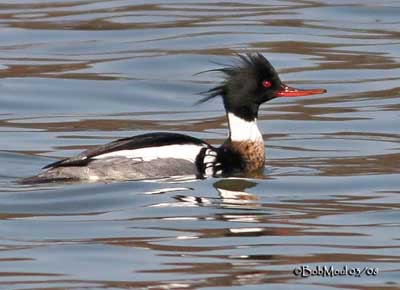
Fr: Harle huppé
All : Mittelsäger
Esp: Serreta Mediana
Ital: Smergo minore
Nd: Middelste Zaagbek
Sd: Småskrake
Photographers:
Steve Garvie
RAINBIRDER Photo galleries
Tom Grey
Tom Grey's Bird Pictures
Eugène Montocchio
Galerie Photos Nature
Bob Moul
Nature Photography
René Lortie
http://rlortie.ca
Text by Nicole Bouglouan
Sources:
HANDBOOK OF THE BIRDS OF THE WORLD vol 1 by Josep del Hoyo-Andrew Elliot-Jordi Sargatal - Lynx Edicions - ISBN: 8487334105
THE COMPLETE BOOK OF BRITISH BIRDS – Written by “Royal Society for the Protection of Birds” experts - Préface de Magnus Magnusson - Michael Cady- Rob Hume Editors - ISBN: 0749509112
GUIDE DES CANARDS, DES OIES ET DES CYGNES – de Steve Madge - Delachaux et Niestlé - ISBN: 2603013769
ENCYCLOPEDIE DES OISEAUX DE FRANCE ET D’EUROPE – de Peter Hayman et Rob Hume - Flammarion – ISBN : 2082009920
Bird Web (Seattle Audubon Society)
The Sea Duck Joint Venture
A Conservation Partnership under the North American Waterfowl Management Plan
What Bird-The ultimate Bird Guide (Mitchell Waite)
Red-breasted Merganser
Mergus serrator
Anseriforme Order – Anatidae Family
BIOMETRICS:
Length: 52-58 cm
Wingspan: 70-86 cm
Weight: 780-1350 g
DESCRIPTION:
The Red-breasted Merganser is an expert diver which can easily disappear underwater to reach a more sheltered place. It mostly depends on fresh water, but it may occur in salt lagoons and bays during the hard winters.

The adult male in breeding plumage has black and white upperparts, with black hind neck, mantle and back, the latter bordered on each side by a broad white stripe. The rump, the uppertail-coverts and the tail are grey with pale-edged feathers, giving scaled effect. The tail has black terminal band.
The upperwing shows black and white pattern with broad white wing patch on the inner part of the wing which is broadly black-tipped. The scapulars are black with white spots.
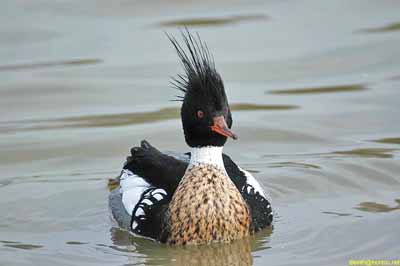
On the underparts, we can see a reddish, mottled black, breast band. The rest of the underparts are white. The grey flanks show wavy black lines. The neck has conspicuous white collar. The elegant body is tapered.
The head is glossy dark green, as chin, nape and upperneck. On the top of the crown and the nape, we can see a bristling crest made with fine dark green feathers.
The slender red-orange bill is typical of the genus Mergus with serrated edges. Eyes, legs and webbed feet are deep red.
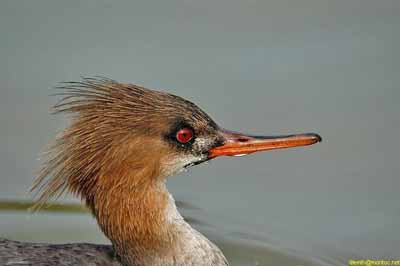
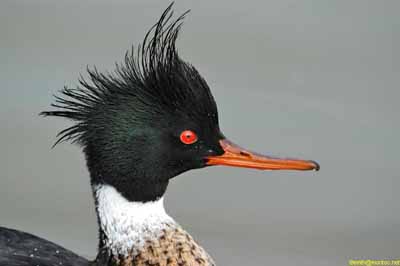
The female is very similar to the female Goosander but her crest is slighter. She has dull grey-brown plumage, whitish breast and reddish-brown head and neck. The upperwing shows less white than in male, and the scapulars are greyish.
Bill, eyes, legs and feet are duller red and she is smaller than male.
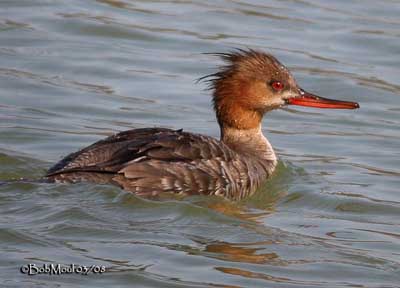
The juvenile resembles female with shorter crest and duller plumage.
The male in eclipse plumage is similar to the female, but the mantle is blacker and it has white wing-coverts.
VOICE: SOUNDS BY XENO-CANTO
The Red-breasted Merganser is rather silent outside the breeding season. But during the displays, the male utters several soft grunts and a low mewing “yeow-yeow”, whereas the female gives sharp and grating calls “krrrr-krrrr”, and also croaks white flying.
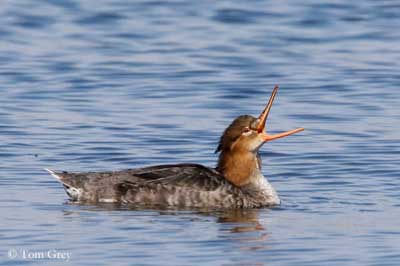
HABITAT:
The Red-breasted Merganser occurs on deep fresh waters such as lakes or small rivers where it can breed, and often in wooded areas, but not always.
It spends the winter at sea, in estuaries, bays or brackish lagoons.
RANGE:
The Red-breasted Merganser breeds across the northern parts of North America, Greenland, Europe and Asia. This migratory species spends the winter on sea-coasts further south.
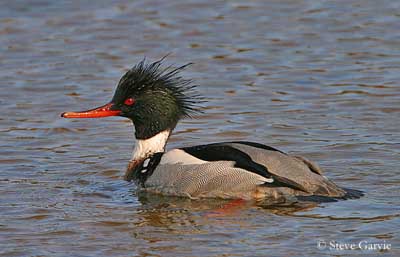
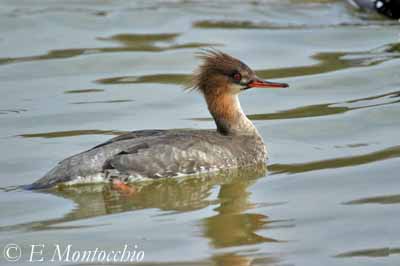
BEHAVIOUR:
The Red-breasted Merganser is an opportunistic feeder, but its diet varies according to the range. It feeds on fish and small crustaceans, and also takes worms, amphibians and insects.
It forages mainly by diving for aquatic preys. It searches for invertebrates underwater with the head submerged, but also takes preys from the surface.
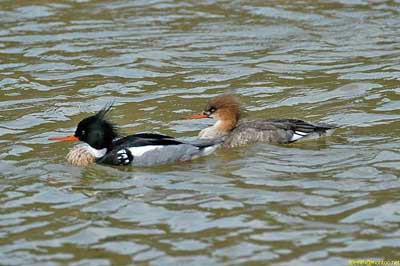
Usually, the pair forms on the wintering areas. They travel in pairs or in small groups of 5-15 birds, with diurnal coastal flights, and nocturnal inland flights.
The female returns to the same nesting site each year. The Red-breasted Merganser breeds at high elevations, in tundra and boreal forests where there are large, deep lakes.
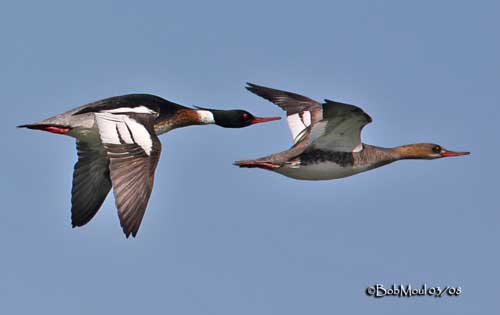
These ducks often live in flocks all year round, and breed in loose colonies, and sometimes with other birds’ species such as Laridae and Eiders. On the wintering grounds, they gather in great numbers.
The courtship displays start as soon as mid-winter. Several movements and postures are observed in order to display the bright plumage pattern of the male.
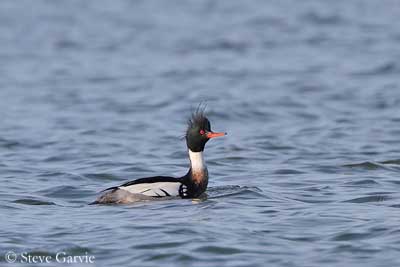
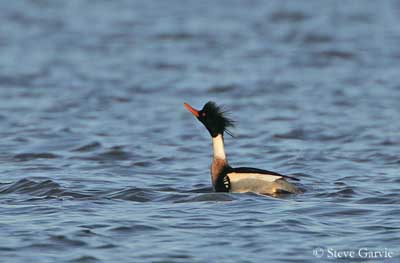

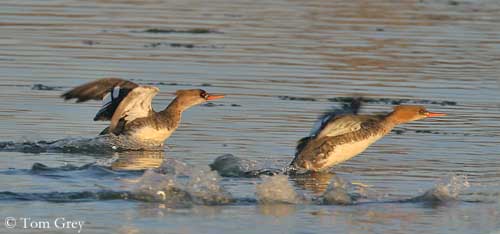
These displays are accompanied by soft grunts. The male holds neck and head upwards to expose the white collar while the crest is erected. Then, it circles around the female with partially submerged body, displaying the red bill and feet.
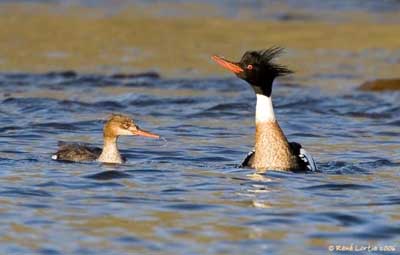
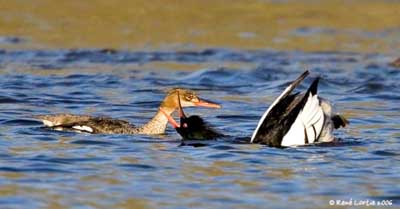
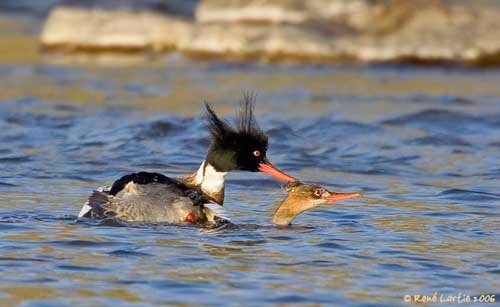
The copulation takes place on the water. The male mounts on the female’s back and pecks softly at her head.
The male remains in the vicinity of the nest-site until the clutch is laid and the female incubating. Then, it leaves the place and reaches the moulting areas (which are poorly known) whereas the female moults with the young on the nesting areas.
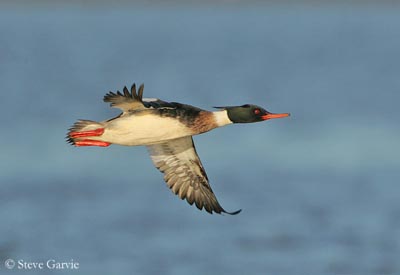
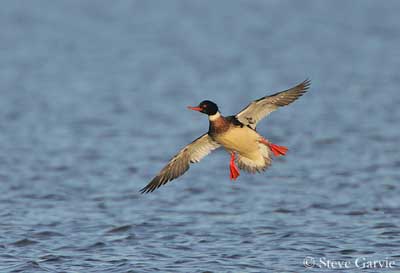
FLIGHT:
The Red-breasted Merganser has fast, direct flight, but it needs to run on the water to take off. Then, it performs rapid wing-beats.
REPRODUCTION:
The breeding season can start in April/June, but often later according to the range.
The Red-breasted Merganser breeds in single pairs or in loose colonies. It nests on the ground near water. It can use sometimes crevices in rocky coasts or islets if available.
The nest is a shallow depression well concealed, often with tall vegetation above forming a kind of roof. It is made with grass and lined with down. As the incubation progresses, the female adds grass and downy feathers.
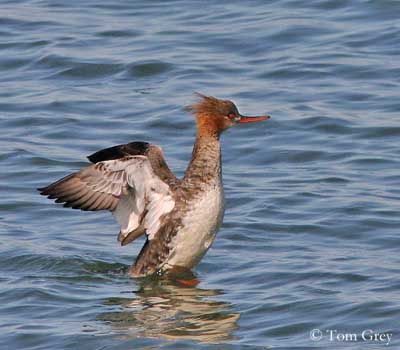
She lays about 8-10 eggs, and other females can lay in the same nest, giving large clutches of up to 24 eggs. She incubates during one month. At hatching, the chicks have brownish down above and white below. They are precocial and often gather in large crèches attended by only one female. They fledge at 60-65 days of age and are sexually mature at two years.
The female can replace the clutch if the eggs are lost.
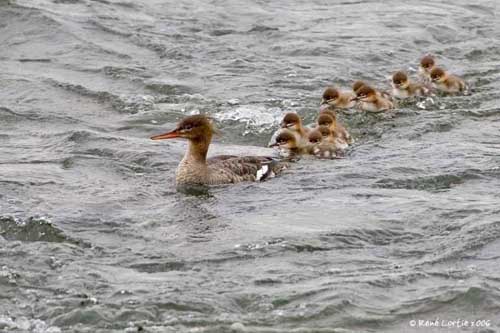
DIET:
The Red-breasted Merganser feeds on fish and small crustaceans such as shrimp and crayfish, and also worms, insects and amphibians. It may take some plant materials.
It feeds by diving from the surface and also pecking at the surface.
The young feed mainly on aquatic invertebrates, small fish and seeds of sedges.
PROTECTION / THREATS / STATUS:
The Red-breasted Merganser is not currently threatened.
In spite of hunting pressure in some parts of the range, this is not a major source of decline.
Water pollution, human developments and destruction of forest are however important threats for this species, but the populations are secure and estimated as Least Concern.